Abstract
We report normative standards for length, weight, 17 craniofacial dimensions, 5 hand and foot measurements, 7 circumferences, 9 skinfold thicknesses, penile length, and testicular volume in black and white newborns. No significant differences in these variables were found between black males and females. White males had greatest craniofacial height, head length, head breadth, minimum frontal diameter, bizygomatic diameter, and head circumference, whereas white females had largest medial calf, thigh, forearm, and subscapular skinfolds. White infants had largest weight, head circumference, head length, head breadth, calf and chest circumferences, and medial calf and forearm skinfolds, whereas nose breadth, mouth breadth, and penile length were greatest in black newborns.
Keywords: anthropometry, standardized curves, black and white newborn infants
INTRODUCTION
Normative anthropometric standards are important in the clinical evaluation of newborns with dysmorphic features for syndrome identification. Unfortunately, only a few comprehensive surveys exist for establishing these standards, especially in relation to gestational age.1–4 In addition, there are several important physical parameters (e.g., testicular volume) in which standards are not available or are limited to certain ethnic groups. The comparison of physical measurements with normative values may be helpful in the diagnosis of syndromes at birth. The role of clinical anthropometry in medical genetics was summarized by Meaney and Farrer.5 We report normative standards for 42 anthropometric variables in 80 black term newborns and 39 variables in 100 white newborns that should be useful in the clinical setting. Anthropometric differences are also reported between the sexes and between black and white newborn infants.
MATERIALS AND METHODS
One hundred eighty (50 white males, 50 white females, 40 black males, 40 black females) healthy, term, newborn infants, appropriate for their gestational age, which ranged from 37 to 42 weeks, were included in this study. Gestational age was determined by the Dubowitz scoring system6 or, when available, was calculated from the first day of the last menstrual period. No congenital anomalies were observed in any of the infants, and the pregnancy histories were unremarkable. Twins and infants of diabetic mothers were not included in this study.
The physical measurements were obtained between 12 and 60 hours after delivery and consisted of the following: length; weight; head circumference; head length and breadth; minimum frontal diameter; ear width and length; craniofacial height (vertex-gnathion); upper face height (nasion-stomion); philtrum length; bizygomatic and bigonial diameters; mouth breadth; inner and outer canthal distances; palpebral fissure length; nose breadth and length (nasion-subnasale); hand length (blacks only); middle finger length (blacks only); fifth finger length; ulnar palm length; foot length (blacks only); upper arm, forearm, thigh, calf, chest, waist, and hip circumferences; subscapular, triceps, biceps, chest, abdomen, suprailiac, thigh, forearm, and medial calf skinfolds; penile length (stretched); and testicular volume. Length was measured with the infants in supine position on a horizontal calibrated board. Skinfold measurements were obtained to the nearest half-millimeter with a Lange skinfold caliper. Circumferences were obtained to the nearest millimeter with a steel tape. Other measurements were taken using either sliding or spreading calipers. Testicular volumes were determined using a Prader Orchiometer or comparable ellipsoid spheres ranging in size from 0.5 to 4.0 ml. All of the anthropometric measurements were made by the same trained observer according to standard techniques as presented by Weiner and Lourie7 and Farkas and Munro.8
To monitor quality control and observer reliability, repeated measurements were obtained on several infants over a period of time by two observers. There appeared to be reasonable agreement (generally <10% discrepancy between original and repeated measurements) with measurements obtained by the same observer. Greater consistencies were found in intraobserver measurements than in the measurements obtained by the two independent observers. Therefore, intraobserver consistency using comparable anthropometric equipment was in agreement with other anthropometric surveys.9
Means and standard deviations were calculated for each of the variables for all groups of infants. Student’s t tests were used to determine significant differences in variables between sexes or races. Where no significant differences were found, the data were combined to form the normative standards for that variable. For example, no significant differences were found between black and white infants for philtrum length, and therefore only one standard curve was produced. The anthropometric data were divided into four gestational age groups (37–38.5, 38.5–39.5, 39.5–40.5, and 40.5–42 wks), which allowed comparable numbers of infants to be included in each group. For each variable, standardized curves were produced by plotting the mean and the 5th and 95th centiles for each age group.
RESULTS
Table 1 shows the gestational age and anthropometric data of the 180 newborn infants. Figures 1 through 13 show standardized curves for all of the measurements as listed above.
Table 1.
Anthropometric Data for 80 Black and 100 White Newborns
| Variable | White | Blacka | ||
|---|---|---|---|---|
| Males ( ) |
Females ( ) |
Males ( ) |
Females ( ) |
|
| Gestational age | 39.23 ± 1.39 | 39.35 ± 1.50 | 39.02 ± 1.50 | 39.34 ± 1.18 |
| Length (cm) | 51.48 ± 2.66 | 50.37 ± 5.28 | 49.89 ± 1.73 | 49.94 ± 2.48 |
| Weight (kg)b | 3.42 ± 0.48 | 3.42 ± 0.49 | 3.21 ± 0.46 | 3.24 ± 0.53 |
| Head circumference (cm)b,c | 35.09 ± 1.27 | 34.41 ± 1.25 | 34.07 ± 1.11 | 34.04 ± 1.19 |
| Head length (cm)b,c | 11.85 ± 0.52 | 11.56 ± 0.45 | 11.55 ± 0.40 | 11.45 ± 0.45 |
| Head breadth (cm)b,c | 9.51 ± 0.41 | 9.27 ± 0.42 | 9.13 ± 0.40 | 9.06 ± 0.42 |
| Minimum frontal diameter (cm)c | 6.94 ± 0.37 | 6.76 ± 0.37 | 6.76 ± 0.37 | 6.79 ± 0.36 |
| Ear width (cm) | 2.44 ± 0.19 | 2.39 ± 0.21 | 2.38 ± 0.22 | 2.34 ± 0.21 |
| Ear length (cm) | 3.64 ± 0.29 | 3.65 ± 0.23 | 3.63 ± 0.27 | 3.60 ± 0.33 |
| Craniofacial height (cm)c | 11.83 ± 1.17 | 11.28 ± 0.78 | 11.66 ± 1.06 | 11.68 ± 0.99 |
| Upper face height (cm) | 3.10 ± 0.23 | 3.15 ± 0.34 | 3.16 ± 0.19 | 3.08 ± 0.31 |
| Philtrum length (cm) | 0.89 ± 0.08 | 0.89 ± 0.09 | 0.92 ± 0.11 | 0.88 ± 0.10 |
| Bizygomatic diameter (cm)c | 7.66 ± 0.45 | 7.45 ± 0.37 | 7.49 ± 0.43 | 7.48 ± 0.40 |
| Bigonial diameter (cm) | 6.07 ± 0.50 | 5.92 ± 0.31 | 5.86 ± 0.38 | 5.97 ± 0.31 |
| Mouth breadth (cm)b | 2.66 ± 0.40 | 2.65 ± 0.32 | 2.80 ± 0.25 | 2.80 ± 0.36 |
| Inner canthal distance (cm) | 2.03 ± 0.13 | 2.01 ± 0.17 | 1.98 ± 0.17 | 1.99 ± 0.16 |
| Outer canthal distance (cm) | 5.93 ± 0.36 | 5.90 ± 0.35 | 5.94 ± 0.34 | 6.01 ± 0.36 |
| Palpebral fissure length (cm) | 1.94 ± 0.13 | 1.95 ± 0.13 | 1.96 ± 0.13 | 2.00 ± 0.15 |
| Nose breadth (cm)b | 2.18 ± 0.15 | 2.11 ± 0.19 | 2.38 ± 0.21 | 2.33 ± 0.22 |
| Nose length (cm) | 1.96 ± 0.24 | 2.02 ± 0.23 | 1.97 ± 0.13 | 1.92 ± 0.22 |
| Hand length (cm) | — | — | 6.53 ± 0.34 | 6.49 ± 0.77 |
| Middle finger length (cm) | — | — | 3.03 ± 0.23 | 3.04 ± 0.26 |
| Fifth finger length (cm) | 2.40 ± 0.16 | 2.39 ± 0.19 | 2.44 ± 0.12 | 2.37 ± 0.26 |
| Ulnar palm length (cm) | 3.02 ± 0.43 | 2.97 ± 0.21 | 3.08 ± 0.21 | 3.12 ± 0.30 |
| Foot length (cm) | — | — | 8.00 ± 0.42 | 7.99 ± 0.44 |
| Upper arm circumference (cm) | 10.04 ± 0.85 | 10.09 ± 0.83 | 10.12 ± 0.89 | 10.18 ± 0.92 |
| Forearm circumference (cm) | 9.38 ± 0.64 | 9.45 ± 0.64 | 9.31 ± 0.77 | 9.14 ± 0.80 |
| Thigh circumference (cm) | 14.46 ± 1.28 | 14.72 ± 1.28 | 14.54 ± 1.52 | 14.33 ± 1.56 |
| Calf circumference (cm)b | 11.10 ± 0.80 | 11.35 ± 0.86 | 10.95 ± 0.95 | 10.87 ± 0.86 |
| Chest circumference (cm)b | 32.83 ± 1.99 | 32.69 ± 1.69 | 32.11 ± 1.71 | 31.75 ± 1.84 |
| Waist circumference (cm) | 32.57 ± 1.99 | 32.64 ± 1.84 | 32.04 ± 2.13 | 31.97 ± 2.00 |
| Hip circumference (cm) | 27.54 ± 2.04 | 27.84 ± 1.51 | 27.14 ± 2.23 | 27.11 ± 2.43 |
| Subscapular skinfold (mm)c | 4.1 ± 0.9 | 4.9 ± 1.2 | 4.3 ± 0.9 | 4.6 ± 1.5 |
| Triceps skinfold (mm) | 3.7 ± 0.9 | 3.9 ± 0.9 | 3.6 ± 0.6 | 3.7 ± 0.9 |
| Biceps skinfold (mm) | 3.2 ± 0.7 | 3.2 ± 0.7 | 3.0 ± 0.5 | 3.1 ± 0.6 |
| Chest skinfold (mm) | 3.0 ± 0.7 | 3.3 ± 0.9 | 3.0 ± 0.5 | 3.1 ± 0.9 |
| Abdomen skinfold (mm) | 3.5 ± 0.6 | 3.6 ± 0.8 | 3.5 ± 0.7 | 3.5 ± 0.8 |
| Suprailiac skinfold (mm) | 3.8 ± 0.8 | 4.0 ± 0.8 | 3.4 ± 1.0 | 3.9 ± 1.5 |
| Thigh skinfold (mm)c | 5.1 ± 1.0 | 5.6 ± 1.1 | 5.0 ± 1.2 | 5.5 ± 1.5 |
| Forearm skinfold (mm)b,c | 3.8 ± 0.8 | 4.1 ± 0.8 | 3.5 ± 0.7 | 3.8 ± 0.9 |
| Medial calf skinfold (mm)b,c | 4.8 ± 1.0 | 5.3 ± 0.9 | 4.2 ± 0.7 | 4.6 ± 1.2 |
| Penile length (cm)b | 2.70 ± 0.43 | — | 3.24 ± 0.64 | — |
| Testicular volume (ml) | 1.1 ± 0.6 | — | 1.1 ± 0.6 | — |
For all variables, no significant (t test; p > 0.05) differences were found between black males and females.
Significant (t test; p < 0.05) difference between white and black infants.
Significant (t test; p < 0.05) difference between white males and white females.
Fig. 1.

Standardized curves of black and white newborns for length, weight, and head circumference.
Fig. 13.
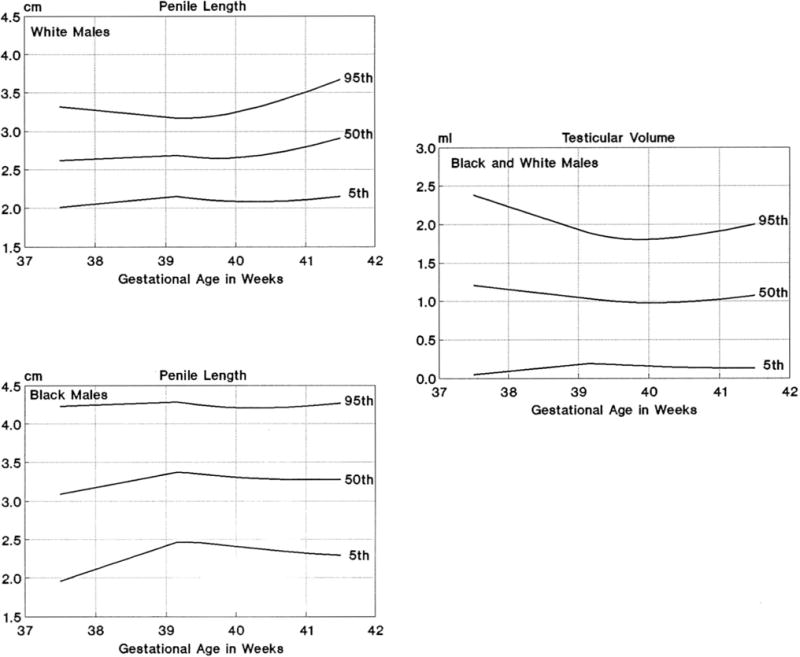
Standardized curves of black and white newborns for penile length and testicular volume.
No significant differences (t test; p > 0.05) in the variables were found between black males and black females. However, significant differences (t test; p < 0.05) were found between white males and white females for craniofacial height, head circumference, head length, head breadth, minimum frontal diameter, bizygomatic diameter, medial calf skinfold, thigh skinfold, forearm skinfold, and subscapular skinfold. Significant differences (t test; p < 0.05) were also found between white and black infants for weight, head circumference, head length, head breadth, nose breadth, mouth breadth, calf circumference, chest circumference, medial calf skinfold, forearm skinfold, and penile length. No significant differences in the average gestational age were found when comparing the various race or sex groups.
DISCUSSION
Our anthropometric data indicate no significant differences between black newborn males and females, but differences were identified between white males and females. These included greater craniofacial height, head length, head breadth, minimum frontal diameter, bizygomatic diameter, and head circumference for white males, and larger medial calf, thigh, forearm, and subscapular skinfolds in white females. Our data also indicate that significant differences exist between white and black infants. White infants have larger weight, head circumference, head length, head breadth, calf and chest circumferences, and medial calf and forearm skinfolds, whereas blacks have greater nose breadth, mouth breadth, and penile length.
There is a paucity of anthropometric studies in newborns, especially in relation to gestational ages, and particularly in black infants. Prior to our study no published U.S. standards existed for black newborns for craniofacial dimensions (excluding palpebral fissure length10), hand and foot measurements, circumferences (excluding upper arm11), skinfold thicknesses (excluding triceps and subscapular11), penile length, and testicular volume. Our study also included several previously unreported normative standards for white newborns, including eight craniofacial dimensions (ear width, nose breadth, nose length, upper face height, craniofacial height, minimum frontal diameter, bizygomatic diameter, and bigonial diameter), two hand measurements (ulnar palm length and fifth finger length), three circumferences (calf, hip, and forearm), three skinfold thicknesses (medial calf, suprailiac, and forearm), and testicular volume. These should be useful for the clinical geneticist, pediatrician, and other health care providers in evaluating black and white newborns with dysmorphic features for syndrome identification.
The use of these standards also may allow for earlier diagnosis and treatment of genetic syndromes. A condition in which they may have direct application is the fragile X syndrome. Based on discriminant analysis, several anthropometric variables (e.g., testicular volume, ear width, head breadth, and bizygomatic diameter) were recently identified and used to classify correctly 95% of fragile X patients when compared with mentally retarded males without the fragile X syndrome.12 Therefore, such standards could be used to identify abnormal anthropometric variables when screening individuals, including newborns, for the fragile X or other syndromes.
Fig. 2.

Standardized curves of black and white newborns for head length and breadth.
Fig. 3.

Standardized curves of black and white newborns for minimum frontal diameter, ear width, and ear length.
Fig. 4.

Standardized curves of black and white newborns for craniofacial height, upper face height, and philtrum length.
Fig. 5.
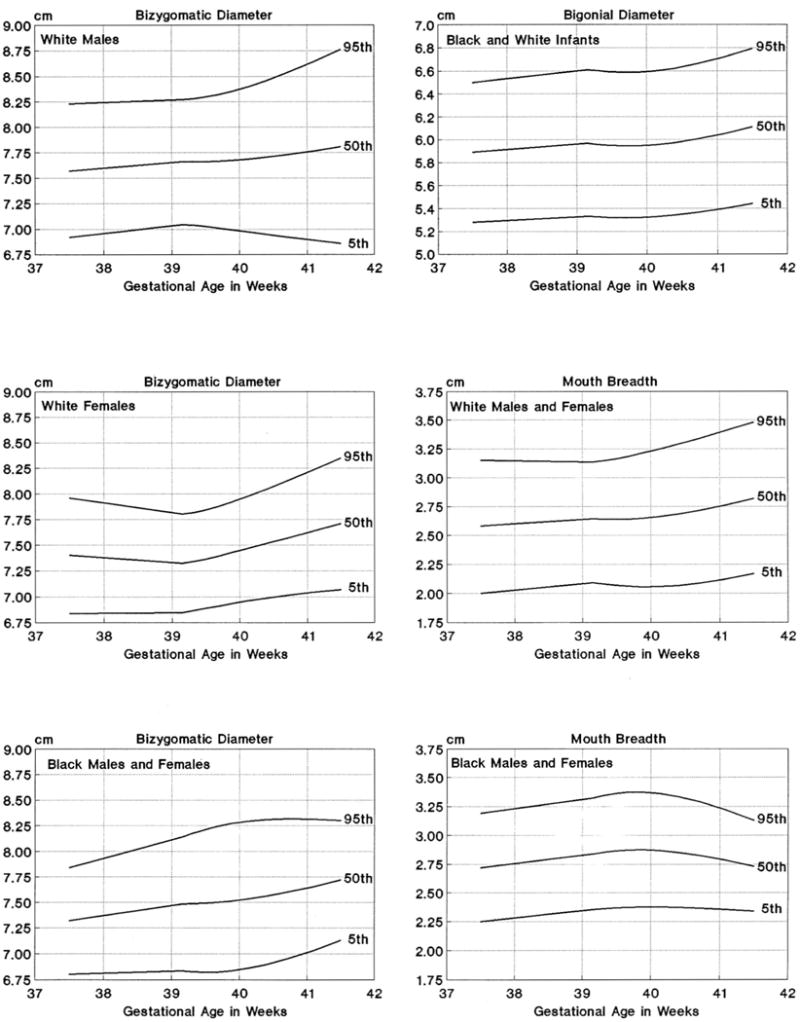
Standardized curves of black and white newborns for bizygomatic diameter, bigonial diameter, and mouth breadth.
Fig. 6.
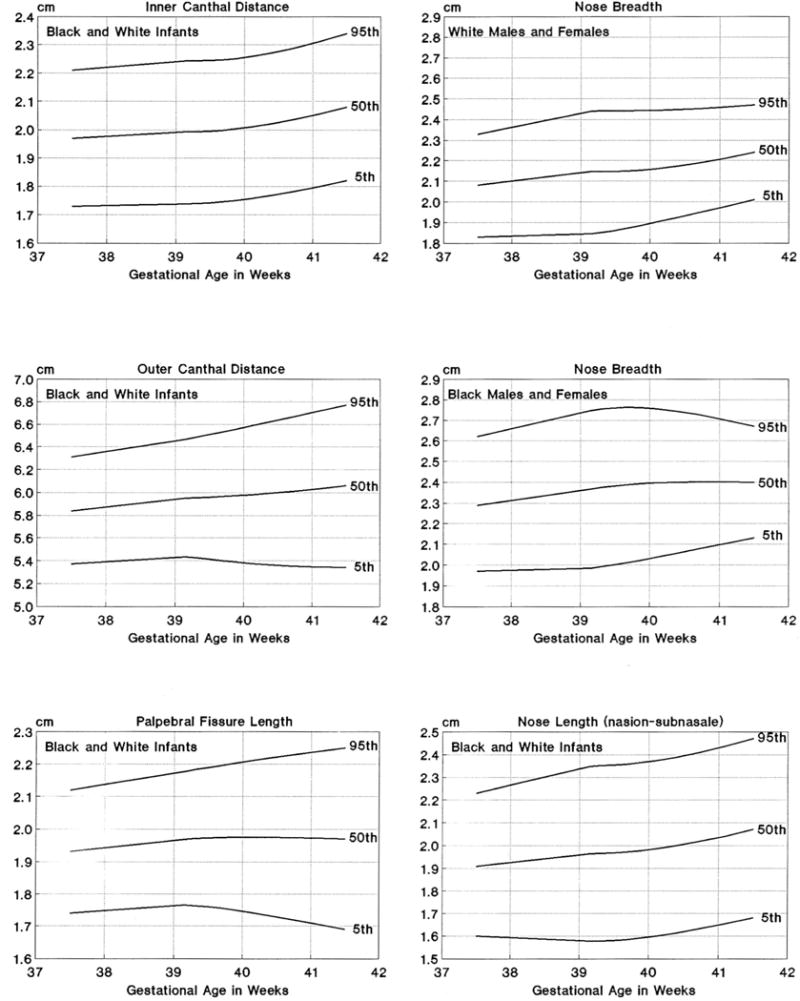
Standardized curves of black and white newborns for inner canthal distance, outer canthal distance, palpebral fissure length, nose breadth, and nose length.
Fig. 7.

Standardized curves of black and white newborns for hand length, middle finger length, fifth finger length, ulnar palm length, and foot length.
Fig. 8.

Standardized curves of black and white newborns for upper arm circumference, forearm circumference, thigh circumference, and calf circumference.
Fig. 9.

Standardized curves of black and white newborns for chest circumference, waist circumference, and hip circumference.
Fig. 10.
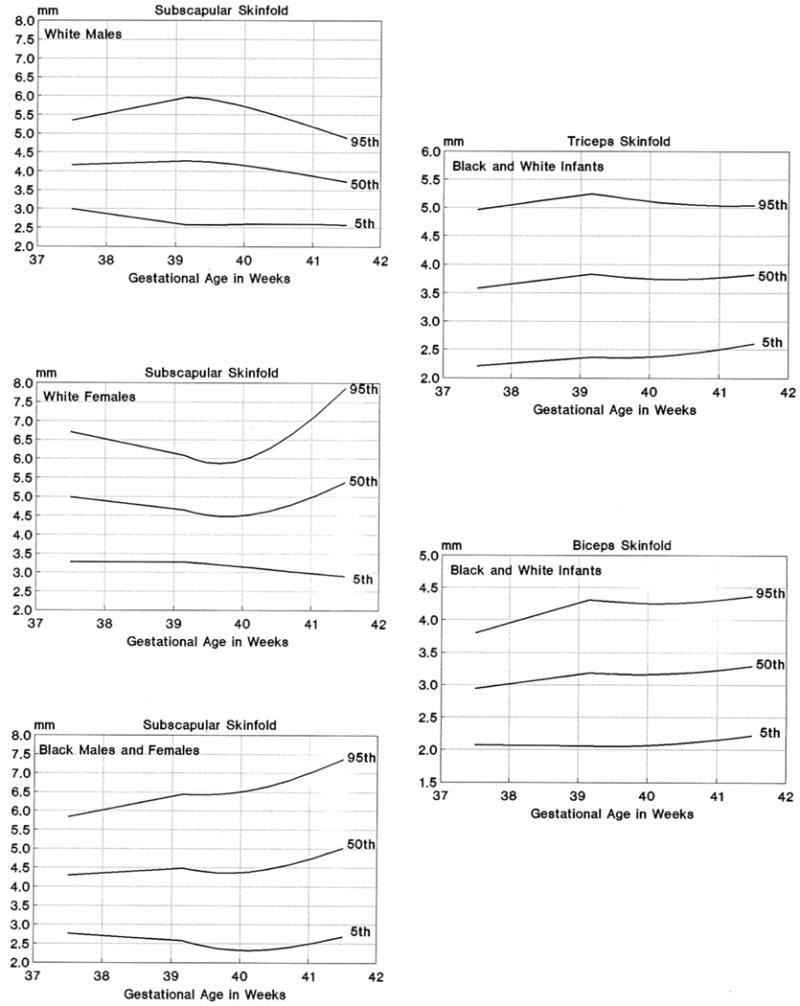
Standardized curves of black and white newborns for subscapular skinfold, triceps skinfold, and biceps skinfold.
Fig. 11.

Standardized curves of black and white newborns for chest skinfold, abdomen skinfold, suprailiac skinfold, and thigh skinfold.
Fig. 12.
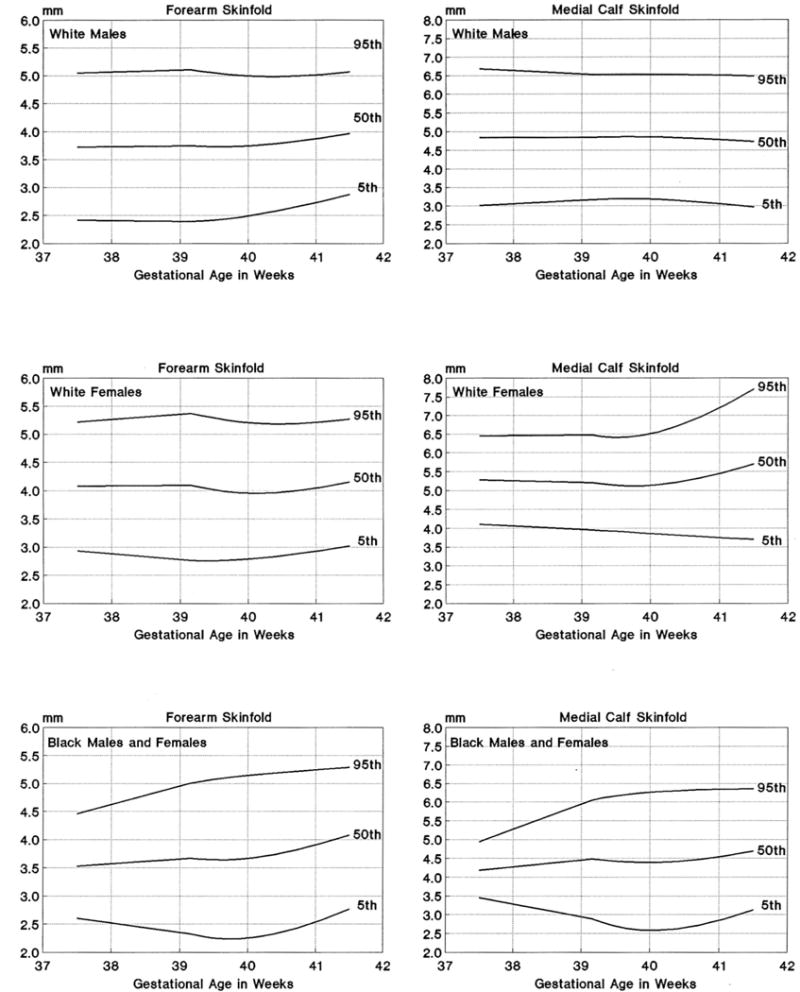
Standardized curves of black and white newborns for forearm skinfold and medial calf skinfold.
Acknowledgments
This research was supported in part by a grant from the Joseph P. Kennedy Foundation. We would like to thank the nursing staff and Dr. Gerald Hickson, Vanderbilt University Medical Center.
References
- 1.Feingold M, Bossert WH. Normal values for selected physical parameters: An aid to syndrome delineation. Birth Defects Original Article Series. 1974;10(13):1–16. [PubMed] [Google Scholar]
- 2.Merlob P, Sivan Y, Reisner SH. Anthropometric measurements of the newborn infant (27 to 41 gestational weeks) Birth Defects Original Article Series. 1984;20(7):1–52. [PubMed] [Google Scholar]
- 3.Hall JG, Froster-Iskenius UG, Allanson JE. Handbook of normal physical measurements. New York: Oxford University Press; 1989. [Google Scholar]
- 4.Dangerfield PH, Taylor CJ. Anthropometric standards for term neonates. Early Hum Dev. 1983;8:223–225. doi: 10.1016/0378-3782(83)90005-1. [DOI] [PubMed] [Google Scholar]
- 5.Meaney FJ, Farrer LA. Clinical anthropometry and medical genetics: A compilation of body measurements in genetic and congenital disorders. Am J Med Genet. 1986;25:343–359. doi: 10.1002/ajmg.1320250221. [DOI] [PubMed] [Google Scholar]
- 6.Dubowitz LMS, Dubowitz V, Goldberg C. Clinical assessment of gestational age in the newborn infant. J Pediatr. 1970;77:1–10. doi: 10.1016/s0022-3476(70)80038-5. [DOI] [PubMed] [Google Scholar]
- 7.Weiner JS, Lourie JA. Human biology. Oxford: Blackwell; 1969. pp. 7–29. [Google Scholar]
- 8.Farkas LG, Munro IR. Anthropometric facial proportions in medicine. Springfield, IL: Charles C Thomas; 1987. pp. 325–336. [Google Scholar]
- 9.National Center for Health Statistics. Vital and health statistics. Washington, DC: U.S. Government Printing Office; 1973. Selected body measurements of children 6–11 years, United States. (Series, 11 no. 123. DHEW publication (HSM) 73–1605). Health Services and Mental Health Administration. [Google Scholar]
- 10.Fuchs M, Iosub S, Bingol N, Gromisch DS. Palpebral fissure size revisited. J Pediatr. 1980;96(1):77–78. doi: 10.1016/s0022-3476(80)80335-0. [DOI] [PubMed] [Google Scholar]
- 11.Johnston FE, Beller A. Anthropometric evaluation of the body composition of black, white, and Puerto Rican newborns. Am J Clin Nutr. 1976;29:61–65. doi: 10.1093/ajcn/29.1.61. [DOI] [PubMed] [Google Scholar]
- 12.Butler MG, Allen GA, Haynes JL, Singh DN. Anthropometric comparison of mentally retarded males with and without the fragile X syndrome. Am J Med Genet. 1990 doi: 10.1002/ajmg.1320380220. in press. [DOI] [PMC free article] [PubMed] [Google Scholar]


